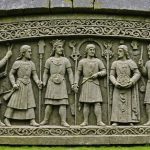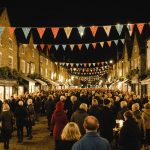Unearth Chester’s Secret Historical Treasures: A Unique Guide to Off-the-Beaten-Path Sites
Chester, a city in the heart of Cheshire, England, is a treasure trove of historical gems waiting to be discovered. From its medieval architecture to its Roman roots, Chester offers a rich tapestry of history that is just begging to be explored. Here’s a comprehensive guide to help you uncover the hidden historical treasures of Chester, taking you on a journey through its lesser-known but equally fascinating sites.
Exploring Chester’s Black-and-White Architecture
One of the most distinctive features of Chester is its black-and-white architecture, a style that has become synonymous with the city. This unique architectural flair is evident in several buildings, each with its own story to tell.
Additional reading : Unforgettable island hopping adventures in palawan
The Northgate Street Terrace
Located on Northgate Street, the terrace known as Shoemakers’ Row or Sadler’s Row is a must-visit. Designed by John Douglas, a prominent local architect, this series of Grade II* and II listed buildings showcases the classic black-and-white timber framing that Chester is famous for. The upper stories of these buildings are adorned with intricate carvings, including depictions of Norman earls and saints, adding to their ornate charm[1].
Saint Ursula’s
On Watergate Street, Saint Ursula’s stands as a testament to Chester’s medieval past. This Grade I listed building features a remarkable undercroft that dates back to the late 12th century, making it one of the oldest dated features within the Chester Rows. The building’s name remains a mystery, but its historical significance is undeniable. The undercroft, with its 5½ bays, is a rare example of medieval craftsmanship, and the structure above has undergone several transformations over the centuries[1].
In the same genre : Discovering your one-of-a-kind photography journey in the breathtaking scottish highlands
Discovering Chester’s Roman Heritage
Chester’s history stretches back to Roman times, and there are several sites that offer a glimpse into this ancient past.
Chester Roman Amphitheatre
The Chester Roman Amphitheatre is one of the largest and most well-preserved Roman amphitheatres in Britain. Located in the heart of the city, this ancient structure is a must-visit for anyone interested in Roman history. The amphitheatre, which could hold up to 7,000 spectators, hosted various events, including gladiatorial contests and public executions. Today, visitors can explore the ruins and gain insights into the daily life of Roman Chester[4].
Roman Walls and Forts
Chester’s Roman walls are another significant historical feature. The city is one of the few in the UK where you can still walk along the original Roman walls. These walls, which date back to the 1st century AD, offer a unique perspective on the city’s Roman past. Additionally, the Roman fort of Deva Victrix, from which Chester gets its name, is an important archaeological site that provides valuable insights into Roman military life[3].
Delving into Chester’s Medieval Past
Chester’s medieval history is as rich as it is fascinating, with numerous sites that showcase the city’s heritage from this period.
Chester Cathedral
Chester Cathedral, formerly the abbey church of a Benedictine monastery dedicated to Saint Werburgh, is a Grade I listed building that spans several centuries of architectural styles. From its Norman roots to its Perpendicular Gothic cloister, the cathedral is a living testament to Chester’s medieval past. The undercroft off the west range of the cloisters, dating from the early 12th century, is particularly noteworthy, having been used by monks for storing food[3].
The Rows
Chester’s Rows are a unique feature of the city’s medieval architecture. These elevated walkways, which date back to the 13th century, were originally used as shops and market stalls. Today, they offer a charming glimpse into Chester’s past, with many of the original buildings still intact. Saint Ursula’s, mentioned earlier, is part of this historic network of Rows[1].
Uncovering Hidden Gems Beyond Chester
While Chester itself is a treasure trove of historical sites, there are also several hidden gems in the surrounding areas that are worth exploring.
Norton Priory Museum & Gardens
Located on the edge of Runcorn, Norton Priory Museum & Gardens is one of Cheshire’s lesser-known historical sites. This medieval monastic site, founded in 1134, features a 12th-century undercroft with a beautiful vaulted ceiling and extensive priory ruins. The museum showcases thousands of objects discovered at the site, telling the 900-year history of the priory and the people who lived there[5].
Northop Hall
Just across the border in Wales, Northop Hall is a picturesque village that offers a blend of historical charm and natural beauty. Visitors can explore the medieval landmarks such as Hawarden Castle and St. Eurgain and St. Peter’s Church, or enjoy the stunning landscapes of the Clwydian Range. For those interested in Roman history, a visit to Flint Castle is also highly recommended[4].
Practical Insights and Actionable Advice
To make the most of your historical tour of Chester and its surroundings, here are some practical tips and recommendations:
Guided Tours
- Walking Tours: Join a guided walking tour to explore Chester’s hidden gems. These tours often include themed walks, such as ghost tours or heritage cruises along the River Dee[2].
- Group Tours: Consider joining a small group tour to get a more personalized experience. These tours can cover a wide range of topics, from Roman history to medieval architecture[2].
Must-Visit Sites
- Chester Cathedral: Don’t miss the Tower Tour at Chester Cathedral, which offers breathtaking panoramic views of the city and its surroundings[2].
- Norton Priory: Spend a day exploring the medieval ruins and gardens at Norton Priory, and discover the 900-year history of this monastic site[5].
Seasonal Activities
- Spring: Enjoy the vibrant gardens and local markets in Northop Hall during the spring season[4].
- Summer: Attend one of the many local festivals in Chester, such as the Together Again Festival, or enjoy outdoor activities like hiking in the Clwydian Range[2][4].
- Autumn: Take in the stunning autumn foliage in Northop Hall and surrounding countryside, and participate in harvest festivals and seasonal food markets[4].
- Winter: Experience the festive charm of Chester and Northop Hall during the winter months, with Christmas markets and cozy retreats[4].
Detailed Itinerary for a Day Tour
Here’s a suggested itinerary for a day tour to explore Chester’s historical treasures:
Morning
- 9:00 AM: Start your day with a walking tour of Chester’s Rows, including a visit to Saint Ursula’s and other historic buildings.
- 11:00 AM: Visit Chester Cathedral and take the Tower Tour for panoramic views of the city.
Afternoon
- 1:00 PM: Enjoy lunch at one of the local eateries in the city center, perhaps trying some traditional English cuisine.
- 2:30 PM: Explore the Roman Amphitheatre and learn about Chester’s Roman heritage.
- 4:30 PM: Take a stroll along the Roman walls and visit some of the other historical sites in the city.
Evening
- 6:30 PM: End your day with a visit to the Chester Rooftop Social, where you can enjoy independent street food and a full-service bar while taking in the city views[2].
Table: Comparing Historical Sites in Chester
| Site | Historical Period | Key Features | Must-See Attractions |
|---|---|---|---|
| Chester Cathedral | Medieval | Perpendicular Gothic cloister, 12th-century undercroft | Tower Tour, medieval architecture, stained-glass windows |
| Saint Ursula’s | Medieval | 12th-century undercroft, black-and-white timber framing | Undercroft, intricate carvings, medieval craftsmanship |
| Roman Amphitheatre | Roman | Largest Roman amphitheatre in Britain | Ruins, historical reenactments, guided tours |
| Norton Priory | Medieval | 12th-century undercroft, priory ruins | Medieval architecture, museum exhibits, beautiful gardens |
| Northop Hall | Medieval | Hawarden Castle, St. Eurgain and St. Peter’s Church | Historical landmarks, natural beauty, local markets |
Quotes and Insights
- “Chester’s black-and-white architecture is not just a visual delight; it’s a testament to the city’s rich history and the innovative approach of architects like John Douglas,” says a local historian.
- “The undercroft at Saint Ursula’s is a rare example of medieval craftsmanship. It’s a must-see for anyone interested in the historical heritage of Chester,” notes a visitor.
- “The Tower Tour at Chester Cathedral offers a unique perspective on the city. It’s a must-do for anyone looking to appreciate the beauty of Chester’s skyline,” advises a local guide.
Chester, with its blend of Roman, medieval, and Victorian heritage, is a city that offers a unique and enriching historical experience. Whether you’re exploring the black-and-white architecture, delving into the city’s Roman past, or uncovering hidden gems in the surrounding areas, Chester has something for every history enthusiast. So, pack your bags, grab your walking shoes, and get ready to unearth the secret historical treasures of this captivating city.
By following this guide, you’ll not only explore the well-known historical sites of Chester but also discover its lesser-known gems, making your journey a truly unforgettable experience. Happy travels











